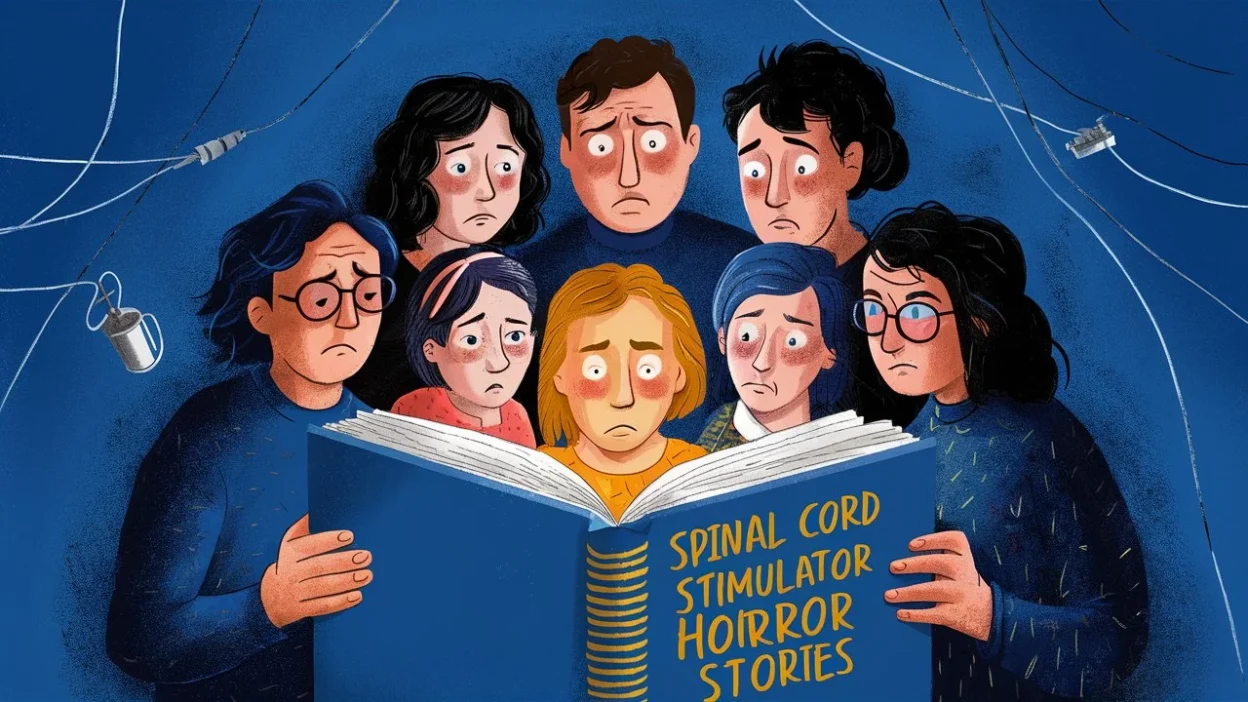Living with chronic pain can drive people to desperate measures, and spinal cord stimulators are often marketed as the best, trending, and top solution in 2025. But not every patient’s experience is positive. For those searching spinal cord stimulator horror stories, this collection dives deep into chilling real-life–inspired tales.
These stories are for adults—especially chronic pain patients, caregivers, and those researching before surgery. By blending caution with storytelling, we’ll reveal what can go wrong when high-tech devices meet human lives. If you’re exploring terms like failed back surgery syndrome, chronic pain horror stories, implant risks, or stimulator nightmares, you’re in the right place.
Story 1: The Constant Buzz
Lena had battled severe back pain for years. When her doctor recommended a spinal cord stimulator, she thought it was the answer. At first, the device dulled the sharp pain, giving her moments of relief. But within weeks, something changed.
She began to feel a constant buzzing in her spine, even when the device was switched off. It was as if invisible bees lived under her skin. Sleep became impossible. Whenever she lay down, the vibration grew stronger, spreading into her legs, and even her teeth felt like they were chattering.
Her doctor insisted it was “just her nerves adjusting,” but Lena knew it wasn’t normal. The buzzing followed her into silence, into work meetings, and even into church pews. She couldn’t escape it. Finally, after a night of unbearable tremors, she begged for the device to be removed.
When they did, she thought it would end. But the phantom buzzing remained. Her nervous system had memorized the torment.
Moral: Sometimes the cure leaves scars that no surgery can remove.
Story 2: The Remote That Wouldn’t Obey
Mark was excited to try his stimulator. With a handheld remote, he was told he could control his pain. “You’ll feel like you’re in charge again,” his surgeon said.
The first week was blissful—at last, relief. Then, one evening, Mark tried lowering the intensity before bed. The device ignored him. He pressed the button again. Nothing. Instead, the current surged higher, stabbing his spine with fiery jolts.
Panic set in. He dropped the remote, but the shocks grew stronger, almost rhythmic, like the device had a mind of its own. His wife rushed in, but even the clinic’s emergency number couldn’t help. The representative said calmly, “Sometimes remotes fail. Try taking the battery out.”
By the time he ripped it open, Mark had collapsed, drenched in sweat, body twitching. The next day, he swore the stimulator had pulsed in sync with his heartbeat—as if it had learned him.
Moral: Technology built to serve can quickly turn into a master.
Story 3: The Infection That Wouldn’t Quit
Carla’s surgery seemed simple. The implant went in smoothly, and she was sent home with instructions to rest. But within days, her incision site grew red, hot, and swollen.
Doctors prescribed antibiotics. They told her not to worry. But the fever spread, and her skin split, leaking foul-smelling fluid. She felt the device pushing against her flesh, as though her body wanted it out.
Night after night, Carla dreamed of wires slithering through her veins, feeding on her like parasites. Her temperature spiked to 104, and she was rushed to the ER. The infection had tunneled deep into her spinal tissue, coiling around the stimulator leads.
Surgery removed the device, but Carla was left with nerve damage and a lifelong limp. Sometimes, when she walks down hospital corridors, she swears she hears a faint mechanical hum, like the device still haunts her body.
Moral: Our bodies know when something doesn’t belong, even if our minds are convinced it’s safe.
Story 4: The Pain That Multiplied
James had lived with failed back surgery syndrome for years. When he heard about spinal cord stimulators, he hoped it was his chance at freedom. The trial phase worked beautifully—so well that he rushed into permanent implantation.
But within weeks, his pain returned, sharper than before. Instead of blocking the signals, the stimulator seemed to multiply them. Every small ache in his back turned into a stabbing burn, each step a fire in his nerves.
When he complained, the clinic suggested reprogramming. They hooked him to a laptop, adjusting frequencies. For a few hours, it seemed better—until the shocks spread to his chest and shoulders. He couldn’t breathe without flinching.
In the end, James had the device removed. But his pain never returned to the “old baseline.” The stimulator had awakened new pathways of suffering.
Moral: Not all promises of relief lead to healing—some open doors to greater pain.
Story 5: The Battery Trap
Sophia was told her rechargeable spinal cord stimulator was “the best, most advanced option in 2025.” She liked the idea—no frequent surgeries to replace batteries. Every night, she plugged in her charging belt before bed.
For months, it worked fine. But then one night, the charger failed. She woke with stabbing shocks racing down her legs. The device had drained overnight, and her nervous system screamed in rebellion.
Panicked, she tried recharging again, but the battery wouldn’t hold power. The company said the unit was defective and needed replacement—but the soonest surgery date was three months away.
Three months of half-charges, power surges, and unpredictable jolts. Sophia stopped sleeping. She couldn’t work. By the time they replaced it, her body was conditioned to fear the charger itself. Even today, the sight of a phone cord makes her flinch.
Moral: Dependence on machines can chain us more tightly than pain itself.
Story 6: The Shocks in the Silence
Paul was an introvert who cherished silence. His spinal cord stimulator, he hoped, would let him return to simple pleasures—like reading alone without pain.
At first, it seemed to work. But then, strange things began happening. When the house grew quiet, he’d feel tiny zaps in his spine. They weren’t random; they pulsed in patterns, like Morse code.
The shocks grew stronger when he turned off all electronics. Sitting in a quiet library, his body twitched uncontrollably. When he asked his doctor, they dismissed it as anxiety.
But Paul kept noticing the pattern. It always appeared at night, always in the silence. He recorded the sensations, mapping them out. To his horror, they formed words—fragments like help me and don’t trust.
Paul ripped the stimulator out during emergency surgery. But sometimes, when he lies awake at night, he swears the words still flicker inside his spine.
Moral: Even the silence can speak when we let machines inside us.
Story 7: The Doctor’s Denial
Evelyn trusted her surgeon completely. “This will change your life,” he promised, holding up the sleek stimulator brochure. She wanted so badly to believe.
The implant went smoothly, but within days, Evelyn felt stabbing pain across her ribs. Worse, her legs jerked violently when the device turned on. She reported everything to her doctor, but he brushed it off as “normal adjustment.”
Weeks turned to months. The jolts only worsened. At night, her legs thrashed so much she couldn’t share a bed with her husband. Still, her doctor insisted the stimulator was “working fine.”
Finally, another physician examined her and found the leads had migrated. They were shocking her muscles, not blocking pain. The device was removed, but Evelyn never forgot the betrayal—how her suffering was dismissed for the sake of a product’s success rate.
Moral: Blind trust in authority can deepen our suffering.
Story 8: The Phantom Hands
Derek loved horror movies, but he never thought his life would resemble one. His stimulator surgery seemed successful at first. But soon, he noticed a strange sensation—like cold hands gripping his lower spine.
At first, he laughed it off. But the feeling grew stronger, wrapping around his hips, pulling him down when he tried to stand. Doctors said it was just nerve stimulation. But Derek swore it felt deliberate, as if something—or someone—was holding on.
One night, lying in bed, the hands tightened so hard he screamed. He couldn’t move. His wife tried to wake him, but he was frozen in terror.
When the device was finally removed, the “hands” faded. Yet Derek never shook the fear that the stimulator had been more than a machine—that something had touched him through it.
Moral: Not every sensation can be explained by science.
Story 9: The Sudden Death of Silence
Marjorie adored quiet country mornings. After her stimulator surgery, she thought she’d finally be able to enjoy them pain-free.
But instead of relief, she began to hear a low hum inside her skull whenever the device was active. At first, it was faint, like distant power lines. Soon, it grew louder—buzzing, crackling, an electric choir no one else could hear.
She begged the company rep for answers. He claimed interference was “impossible.” Yet the hum followed her everywhere, building into shrieks at night until she clutched her head in agony.
Even after removal, Marjorie still wakes to phantom static. She says silence itself died the day they put that machine inside her.
Moral: When we tamper with the nervous system, we risk destroying what we most cherish.
Story 10: The Final Pulse
Raymond had lived with his stimulator for five years. It wasn’t perfect, but it kept his pain manageable. Then, one morning, it pulsed violently—stronger than ever before.
He staggered, clutching his spine as though lightning ripped through him. His device wouldn’t shut off. Each jolt was worse than the last, sending him to his knees. His wife called an ambulance, but by the time paramedics arrived, Raymond was unresponsive.
Doctors ruled it a “device malfunction.” But his wife swore she saw the shocks ripple through his body like waves, almost timed like a countdown.
The stimulator was removed from his body, inert and silent, but the memory haunted his family. A machine built to prolong life had taken it in a single surge.
Moral: The line between healing and harm is razor thin.
Conclusion
These 10 spinal cord stimulator horror stories show the hidden risks behind what’s marketed as one of the best trending pain treatments in 2025. Patients with chronic pain, failed back surgery syndrome, and neuropathy often search for miracle solutions, but every device carries dangers—from infections and jolts to psychological trauma and malfunction.
For anyone considering an implant, remember: ask questions, seek second opinions, and weigh every risk. Relief should never cost you your peace of mind.




